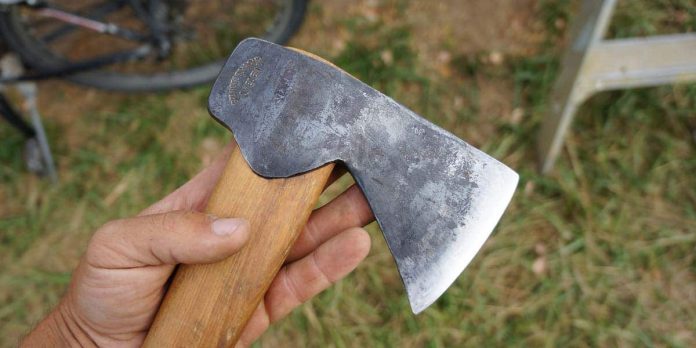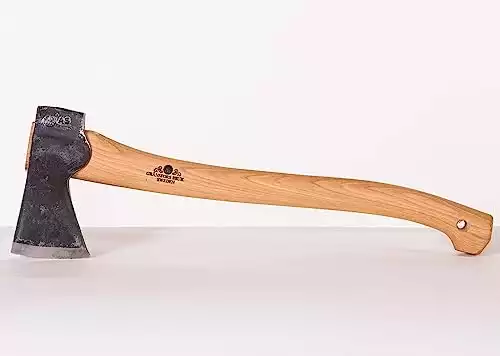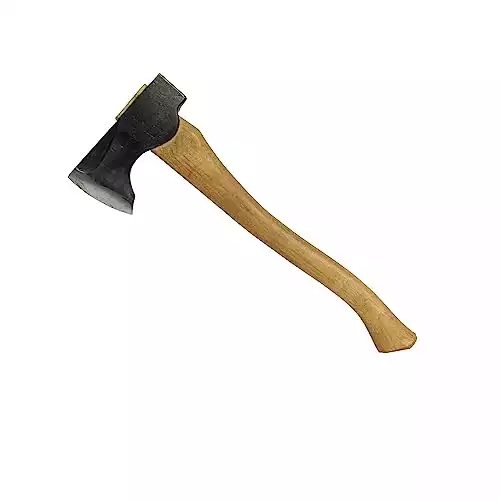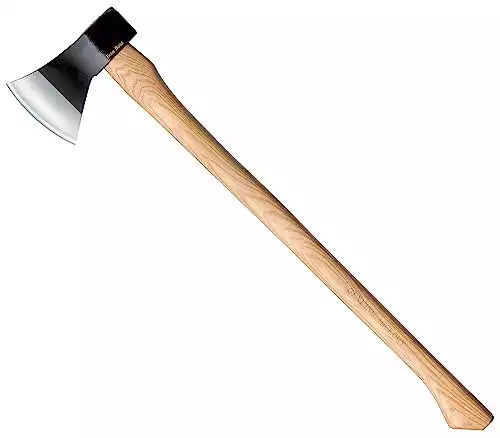Today, axes have mostly been replaced by saws and survival knives. However, there was once a time when outdoors people didn’t go out without an axe.
If you are serious about learning wilderness skills, you will need a good bushcraft axe to take out with you.
Our Top Pick
Gransfors Bruks Small Forest Axe 19 Inch
Durable and beautifully balanced with stunning design, what’s not to love about the Gransfors Bruk Small Forest axe?
Performs any task effortlessly, from butchering game to splitting wood and even delicate carving jobs.
Weight:
2lbs
Length:
19″
Material:
Ovako Steel
Made In:
Sweden
Warranty:
20 Years
Bushcraft Axe – Comparison Table
The Best 5 Bushcraft Axes
Gransfors Bruk Small Forest
This axe is regularly on best-of lists. It is versatile and does a good job chopping for such a small axe. Gransfors Bruk is famous for its high quality, and you won’t be disappointed.
The only major complaint is that it is too small for heavy chopping.
If you already know you need to do serious work, opt for their bigger, heavier Large Splitting Axe.
If you need to do lighter work, size down to their Wildlife hatchet or Outdoor Axe.
Features
- Weight: 2lbs
- Length: 19″
- Head material: Ovako Steel
- Made in: Sweden
- Warranty: 20 years
Pros
- Incredible craftsmanship
- Great chopping power for a small axe
- Leather sheath
- Hand forged
- High-grade hickory handle
- Great warranty
Cons
- Expensive
- Too light for heavy chopping
Council Tool Woodcraft Pack
This is an excellent bushcraft axe, though it isn’t as versatile as some. I love it because of the beautiful bit design.
The bit is shaped to reduce weight but without reducing function. The heaviest area of the bit still creates the greatest impact, allowing it to be used for splitting wood effectively.
The main draw is that it is designed for carving and wood shaping. The bit feels great in your hands – even when wearing winter gloves. I find it useful for camp tasks like making tinder or wood stakes. Of course, a survival knife would work for these tasks too.
The major downside of Council Tool axes is their fairly low Rockwell hardness.
The idea is that they can be used better on hardwood in wintertime (low Rockwell will be less brittle in these conditions). But this does mean you need to sharpen it a bit more frequently.
Unlike the hand-forged Swedish-made axes, the Council Tool axe is drop forged.
This is how you can get such a high-quality axe made in the USA at prices similar to the Swedish hand-forged axes.
Features
- Weight: 3.79lbs
- Length: 19″
- Head material: 5160 steel
- Made in: USA
- Warranty: 5 years
Pros
- Great bit design
- Leather sheath
- Comfortable curved handle
- High-grade hickory handle
- Made in the USA
Cons
- Not as versatile
- Low Rockwell hardness
Husqvarna 26” Multi Purpose
Husqvarna axes are the “value” brand of Swedish axes. Even though many Husqvarna products are now apparently made in China, this multi-purpose axe is still Swedish made.
There are many good things about this chopper – like how it maintains sharpness well, has a handle long enough for safe beginner use, and is versatile.
Overall, it is a decent balance between quality and budget.
For the low price, though, you can’t expect it to be perfect.
There are some reported issues with the axe head breaking in half – even with proper usage.
The handle is hickory but low-grade hickory with wide grain. This means that the handle could also break on you. Overall, it’s not the best choice for hardwoods.
Features
- Weight: 3lbs
- Length: 26″
- Head material: Not specified
- Made in: Sweden
- Warranty: 90 days
Pros
- Great value
- Retains edge well
- Long handle is better for beginners
- Leather scabbard
Cons
- Users report issues with head breaking
- Low-quality hickory handle
- Handle will shrink in warm climates
- Type of steel not given
Cold Steel Trail Boss
I had to include the Cold Steel Trail Boss in our list, primarily because of its low price. As you’d expect for such a cheap tool, it doesn’t come close to the quality of the Swedish-made and Council Tool axes.
For a cheap product, though, it holds up surprisingly well.
The head doesn’t come loose. The handle doesn’t break (though some report it cracks when you hit a knot in hardwood).
And the head holds up even when you miss a few swings. You can use it for limbing trees and splitting wood (don’t expect to split seasoned wood).
Do note that the head rusts easily. You will need to keep oil on it to protect it.
Still, it is pretty impressive for such a cheap tool.
Features
- Weight: 2.7lbs
- Length: 26″
- Head material: 1055 steel
- Made in: Taiwan
- Warranty: 30 days
Pros
- Great for beginners
- Very affordable
- Comfortable handle
- Grade-A hickory handle
Cons
- Made in Taiwan
- Poor quality control
- No sheath
- Rusts easily
- Still a cheap product – it won’t hold up for serious work
Why Use a Bushcraft Axe?
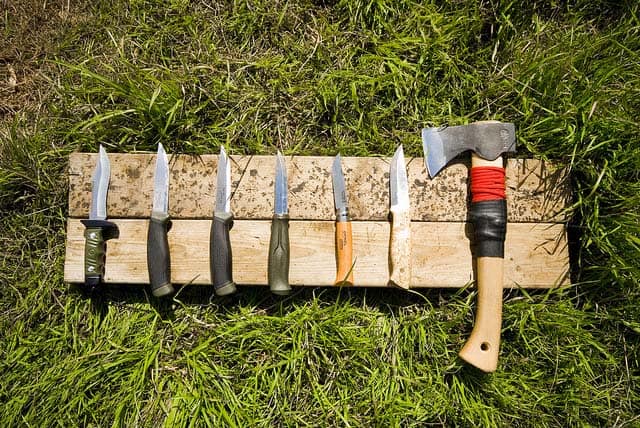
No matter how good your survival knife is, it can’t do tasks like fell a tree. A saw might be a helpful tool, but it isn’t nearly as versatile as an axe – it won’t split or carve wood.
Thus, having a bushcraft axe with you in the wilderness means you will have access to many more materials.
Consider the difference between a simple lean-to shelter and a notched log cabin – you’ll see how much this tool can do for your comfort and survival.
The downside, however, is that axes are very heavy. No serious backpacker would ever consider bringing an axe, and an axe probably won’t make it onto your bug out bag list.
So when does the weight of an axe make it worth carrying?
- When you are bugging out by vehicle, and won’t have to haul your gear very far to camp.
- You will stay at camp for a long time, making the weight worth carrying.
- You know that you will be doing heavy tasks such as limbing trees.
- You want to practice your axe skills to become a better survivalist.
Choosing Your Chopper
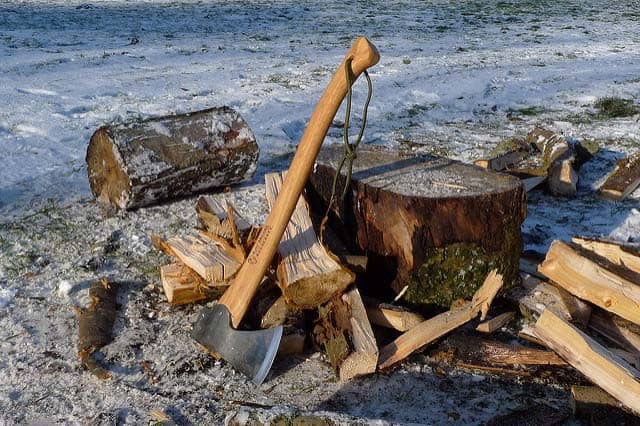
For the beginner axman, the primary considerations are size and weight; however, there is a lot more to choosing than this.
Let’s get into the factors you need to consider before buying. Start by reading The US Department of Agriculture’s guide on axes, including how to use an axe. You can download the PDF here for free.
1. How Comfortable Are You with an Axe?
The first consideration is your skill level.
Many beginners make the mistake of choosing a small hatchet as their first axe. Hatchets are a terrible choice:
- Because the follow-through zone of a hatchet is the thighs and knees, hatchets are more dangerous to use than an axe with a longer handle.
- Hatchets require more energy to use. This can be tiresome for beginners who haven’t mastered their swing yet.
If you are a beginner, then I’d recommend getting a full-length axe or a ¾ axe. They will be heavier to carry but are much safer to use. You’ll also be able to perform more tasks with the longer axes.
*Most outdoors people don’t have just one axe. Whatever you end up choosing, consider it your “first axe.”
You’ll soon have at least one other, so you can take the tool best suited for the tasks you will be doing in the bush.
2. What Do You Want to Use It For?
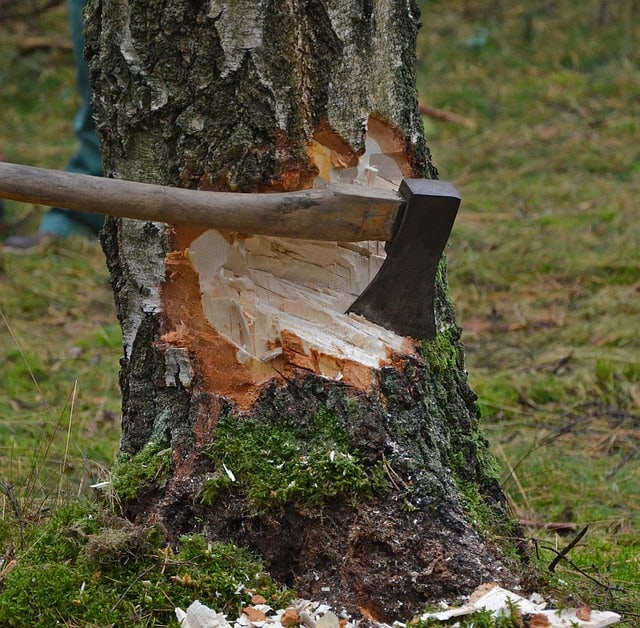
There are a lot of different ax skills to master, such as:
- Felling trees
- Limbing (removing limbs from trees)
- Chopping wood
- Splitting wood
- Dressing animals (an axe can be used to remove limbs from game)
- Chopping ice
- Carving
There are different axes for each of these different skills. However, it is unlikely that you will be doing all of these tasks.
For example, it is prohibited to fell trees in many areas. You are probably better off with a good survival knife than trying to use an axe for carving.
Once you know what you want to do with the axe, you can choose the appropriate type.
- General Duty Axes: If this is your first bushcraft axe, then you will probably be getting a “general duty” axe. These have rounded bits that are suited for a wide range of tasks.
- Cutting Axes: These axes have heavy, thin bits that deliver maximum force on a small area.
- Splitting Axes: Axes with heavy, wider bits are better for splitting as the wedge shape forces the wood apart.
- Hatchets: These are axes with shorter handles and lighter bits. They are best for smaller jobs. A hatchet can be used for splitting and felling, but it will require a lot of energy and be more dangerous.
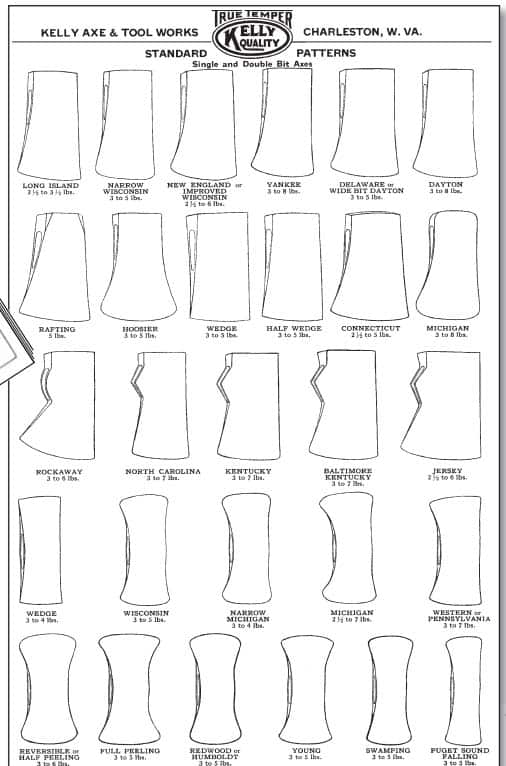
More on the many different types of axes.
3. Efficiency (Size and Weight)
Note: Anything less than a 2-2 ½ pound axe is too light for serious work
An axe works by using the weight of the bit to cut through wood. The heavier the axe bit, the better it will cut through wood.
The tradeoff is that you will work a lot slower with a heavy chopper. If you haven’t mastered your swing and often miss the mark, then you’ll quickly become fatigued.
Because of these issues, lighter bushcraft axes tend to be the most popular. For example, the Gransfors Bruks Small Forest Axe (reviewed below) is 2 lbs. They are more comfortable for beginners to master the swing with and easier to carry in a pack.
The compromise? A three-quarter axe (18-28 inch handle) weighing 2.5 to 3 pounds is a good choice for beginners. It’s heavy enough for some serious work but light enough that you won’t become fatigued quickly or hurt yourself if you miss.
* Don’t forget to consider how you will carry the bushcraft axe. You want to make sure it will fit in or on your bushcraft backpack!
4. Type of Wood
Some of the most popular axes are made in Sweden. Ironically, these axes are made for softer woods, not the hardwoods found throughout most American forests.
If you plan on chopping any hardwood with your bushcraft ax, you will need something with more heft.
A lightweight ax will bounce right off the wood.
If the wood has been seasoned, you’ll need a bit weighing at least 3.5 lbs.
5. Axe Manufacturers
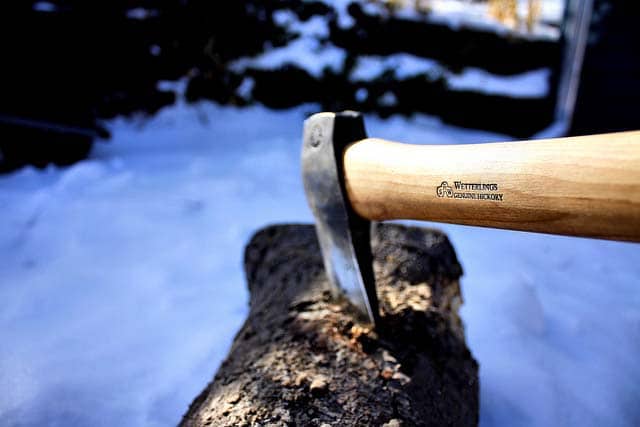
Please do not buy a cheap tool made by no-name Chinese manufacturers! These axes are of untested quality. You could end up severely injuring yourself when the bit goes flying off.
And any money saved by buying a cheap axe will just be negated when you have to replace the handle frequently.
Instead, choose one of the better-known axe manufacturers. These axes will cost more initially but will hold up through the test of time.
- Gransfors Bruks: These Swedish axes are frequently listed as the best. They go through a rigorous quality control process.
- SA Wetterlings: Another Swedish manufacturer, these are similar to the Gransfors Bruks but cost less.
- Council Tool: This is one of my favorite manufacturers. They are based in the USA and offer a variety of designs. They also do a great job of heat-treating their axes.
- Barco: This American company makes very high-quality products at a good value. Many of their axes come unfinished – you will have to grind them yourself.
- Husqvarna: Large well-known manufacturer. Their products vary in quality and price but are generally good value.
What’s your favorite bushcraft axe? Let us know in the comments!

